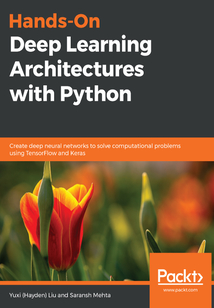舉報 

會員
Hands-On Deep Learning Architectures with Python
Deeplearningarchitecturesarecomposedofmultilevelnonlinearoperationsthatrepresenthigh-levelabstractions;thisallowsyoutolearnusefulfeaturerepresentationsfromthedata.Thisbookwillhelpyoulearnandimplementdeeplearningarchitecturestoresolvevariousdeeplearningresearchproblems.Hands-OnDeepLearningArchitectureswithPythonexplainstheessentiallearningalgorithmsusedfordeepandshallowarchitectures.Packedwithpracticalimplementationsandideastohelpyoubuildefficientartificialintelligencesystems(AI),thisbookwillhelpyoulearnhowneuralnetworksplayamajorroleinbuildingdeeparchitectures.Youwillunderstandvariousdeeplearningarchitectures(suchasAlexNet,VGGNet,GoogleNet)witheasy-to-followcodeanddiagrams.Inadditiontothis,thebookwillalsoguideyouinbuildingandtrainingvariousdeeparchitecturessuchastheBoltzmannmechanism,autoencoders,convolutionalneuralnetworks(CNNs),recurrentneuralnetworks(RNNs),naturallanguageprocessing(NLP),GAN,andmore—allwithpracticalimplementations.Bytheendofthisbook,youwillbeabletoconstructdeepmodelsusingpopularframeworksanddatasetswiththerequireddesignpatternsforeacharchitecture.Youwillbereadytoexplorethepotentialofdeeparchitecturesintoday'sworld.
目錄(202章)
倒序
- coverpage
- Title Page
- Copyright and Credits
- Hands-On Deep Learning Architectures with Python
- About Packt
- Why subscribe?
- Packt.com
- Contributors
- About the authors
- About the reviewers
- Packt is searching for authors like you
- Preface
- Who this book is for
- What this book covers
- To get the most out of this book
- Download the example code files
- Download the color images
- Conventions used
- Get in touch
- Reviews
- Section 1: The Elements of Deep Learning
- Getting Started with Deep Learning
- Artificial intelligence
- Machine learning
- Supervised learning
- Regression
- Classification
- Unsupervised learning
- Reinforcement learning
- Deep learning
- Applications of deep learning
- Self-driving cars
- Image translation
- Machine translation
- Encoder-decoder structure
- Chatbots
- Building the fundamentals
- Biological inspiration
- ANNs
- Activation functions
- Linear activation
- Sigmoid activation
- Tanh activation
- ReLU activation
- Softmax activation
- TensorFlow and Keras
- Setting up the environment
- Introduction to TensorFlow
- Installing TensorFlow CPU
- Installing TensorFlow GPU
- Testing your installation
- Getting to know TensorFlow
- Building a graph
- Creating a Session
- Introduction to Keras
- Sequential API
- Functional API
- Summary
- Deep Feedforward Networks
- Evolutionary path to DFNs
- Architecture of DFN
- Training
- Loss function
- Regression loss
- Mean squared error (MSE)
- Mean absolute error
- Classification loss
- Cross entropy
- Gradient descent
- Types of gradient descent
- Batch gradient descent
- Stochastic gradient descent
- Mini-batch gradient descent
- Backpropagation
- Optimizers
- Train test and validation
- Training set
- Validation set
- Test set
- Overfitting and regularization
- L1 and L2 regularization
- Dropout
- Early stopping
- Building our first DFN
- MNIST fashion data
- Getting the data
- Visualizing data
- Normalizing and splitting data
- Model parameters
- One-hot encoding
- Building a model graph
- Adding placeholders
- Adding layers
- Adding loss function
- Adding an optimizer
- Calculating accuracy
- Running a session to train
- The easy way
- Summary
- Restricted Boltzmann Machines and Autoencoders
- What are RBMs?
- The evolution path of RBMs
- RBM architectures and applications
- RBM and their implementation in TensorFlow
- RBMs for movie recommendation
- DBNs and their implementation in TensorFlow
- DBNs for image classification
- What are autoencoders?
- The evolution path of autoencoders
- Autoencoders architectures and applications
- Vanilla autoencoders
- Deep autoencoders
- Sparse autoencoders
- Denoising autoencoders
- Contractive autoencoders
- Summary
- Exercise
- Acknowledgements
- Section 2: Convolutional Neural Networks
- CNN Architecture
- Problem with deep feedforward networks
- Evolution path to CNNs
- Architecture of CNNs
- The input layer
- The convolutional layer
- The maxpooling layer
- The fully connected layer
- Image classification with CNNs
- VGGNet
- InceptionNet
- ResNet
- Building our first CNN
- CIFAR
- Data loading and pre-processing
- Object detection with CNN
- R-CNN
- Faster R-CNN
- You Only Look Once (YOLO)
- Single Shot Multibox Detector
- TensorFlow object detection zoo
- Summary
- Mobile Neural Networks and CNNs
- Evolution path to MobileNets
- Architecture of MobileNets
- Depth-wise separable convolution
- The need for depth-wise separable convolution
- Structure of MobileNet
- MobileNet with Keras
- MobileNetV2
- Motivation behind MobileNetV2
- Structure of MobileNetV2
- Linear bottleneck layer
- Expansion layer
- Inverted residual block
- Overall architecture
- Implementing MobileNetV2
- Comparing the two MobileNets
- SSD MobileNetV2
- Summary
- Section 3: Sequence Modeling
- Recurrent Neural Networks
- What are RNNs?
- The evolution path of RNNs
- RNN architectures and applications
- Architectures by input and output
- Vanilla RNNs
- Vanilla RNNs for text generation
- LSTM RNNs
- LSTM RNNs for text generation
- GRU RNNs
- GRU RNNs for stock price prediction
- Bidirectional RNNs
- Bidirectional RNNs for sentiment classification
- Summary
- Section 4: Generative Adversarial Networks (GANs)
- Generative Adversarial Networks
- What are GANs?
- Generative models
- Adversarial – training in an adversarial manner
- The evolution path of GANs
- GAN architectures and implementations
- Vanilla GANs
- Deep convolutional GANs
- Conditional GANs
- InfoGANs
- Summary
- Section 5: The Future of Deep Learning and Advanced Artificial Intelligence
- New Trends of Deep Learning
- New trends in deep learning
- Bayesian neural networks
- What our deep learning models don't know – uncertainty
- How we can obtain uncertainty information – Bayesian neural networks
- Capsule networks
- What convolutional neural networks fail to do
- Capsule networks – incorporating oriental and relative spatial relationships
- Meta-learning
- One big challenge in deep learning – training data
- Meta-learning – learning to learn
- Metric-based meta-learning
- Summary
- Other Books You May Enjoy
- Leave a review - let other readers know what you think 更新時間:2021-06-24 14:48:52
推薦閱讀
- 大數據技術與應用基礎
- Dreamweaver CS3+Flash CS3+Fireworks CS3創意網站構建實例詳解
- Google Cloud Platform Cookbook
- IoT Penetration Testing Cookbook
- 傳感器技術應用
- 分布式多媒體計算機系統
- 完全掌握AutoCAD 2008中文版:綜合篇
- WordPress Theme Development Beginner's Guide(Third Edition)
- Excel 2007技巧大全
- 過程控制系統
- 穿越計算機的迷霧
- Hands-On Microservices with C#
- 軟測之魂
- JSP網絡開發入門與實踐
- Appcelerator Titanium Smartphone App Development Cookbook(Second Edition)
- Flash CS3動畫制作融會貫通
- 7天精通Photoshop CS5平面視覺設計
- 單片機C語言編程實踐
- Internet of Things for Architects
- Machine Learning with R Quick Start Guide
- ESP8266 Internet of Things Cookbook
- 機器人系統設計與制作:Python語言實現(原書第2版)
- Force.com Enterprise Architecture(Second Edition)
- 中小型局域網構建實踐
- Healthcare Analytics Made Simple
- 實時數據處理和分析指南
- Modern Computer Architecture and Organization
- Learning Elastic Stack 7.0(Second Edition)
- 學會提問,駕馭AI:提示詞從入門到精通
- INSTANT Chef Starter

